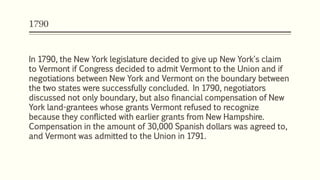Alexander Hamilton (1755/1757-1804) was a founding father of the United States and the first Secretary of the Treasury. He played a pivotal role in establishing the nation's financial system and was a leader in seeking a stronger federal government. However, he had a long-standing rivalry with Aaron Burr that culminated in a 1804 duel where Burr fatally shot Hamilton. Hamilton made major contributions in his roles in Washington's administration and as a writer of the Federalist Papers, but his death in the duel with Burr weakened the Federalist party and ended his political career.






![Whiskey tax
A new U.S. federal government began operating in 1789,
following the ratification of the United States Constitution. The
previous central government under the Articles of Confederation
had been unable to levy taxes; it had borrowed money to meet
expenses and fund the Revolutionary War, accumulating $54
million in debt. The state governments had amassed an
additional $25 million in debt.[6] Secretary of the Treasury
Alexander Hamilton sought to use this debt to create a financial
system that would promote American prosperity and national
unity. In his Report on Public Credit, he urged Congress to
consolidate the state and national debts into a single debt that
would be funded by the federal government. Congress approved
these measures in June and July 1790
Alexander Hamilton in a
1792 portrait by John
Trumbull](https://image.slidesharecdn.com/alexanderhamilton-210301164010/85/Alexander-Hamilton-7-320.jpg)







![His mother
Hamilton's mother had been married previously to Johann Michael Lavien, a
Danish or German merchant, on St. Croix in the Virgin Islands, then ruled by
Denmark. They had one son, Peter Lavien. In 1750, Faucette left her husband and
first son; then traveled to Saint Kitts where she met James Hamilton. Hamilton
and Faucette moved together to Nevis, her birthplace, where she had inherited a
seaside lot in town from her father.
James Hamilton later abandoned Rachel Faucette and their two sons, James Jr.
and Alexander, allegedly to "spar[e] [her] a charge of bigamy... after finding out
that her first husband intend[ed] to divorce her under Danish law on grounds of
adultery and desertion." Thereafter, Rachel moved with her two children to St.
Croix, where she supported them by keeping a small store in Christiansted.](https://image.slidesharecdn.com/alexanderhamilton-210301164010/85/Alexander-Hamilton-15-320.jpg)

![Hamilton proved capable
Hamilton proved capable enough as a trader to be left in charge of the firm for
five months in 1771 while the owner was at sea. He remained an avid reader and
later developed an interest in writing. He began to desire a life outside the island
where he lived. He wrote a letter to his father that was a detailed account of a
hurricane which had devastated Christiansted on August 30, 1772. Hugh Knox, a
minister and journalist, published the letter in the Royal Danish-American
Gazette. The biographer Ron Chernow found the letter astounding for two
reasons; first, that "for all its bombastic excesses, it does seem wondrous [that a]
self-educated clerk could write with such verve and gusto," and second, that a
teenage boy produced an apocalyptic "fire-and-brimstone sermon" viewing the
hurricane as a "divine rebuke to human vanity and pomposity." The essay
impressed community leaders, who collected a fund to send Hamilton to the
North American colonies for his education.](https://image.slidesharecdn.com/alexanderhamilton-210301164010/85/Alexander-Hamilton-17-320.jpg)





















